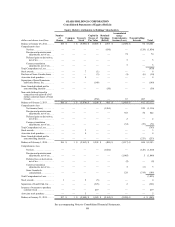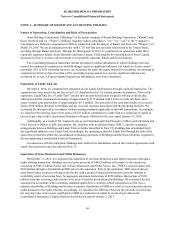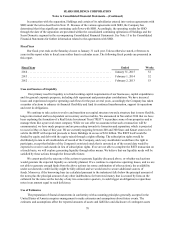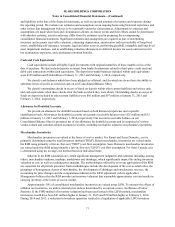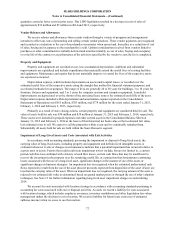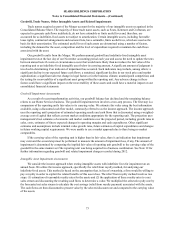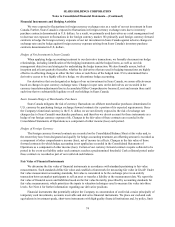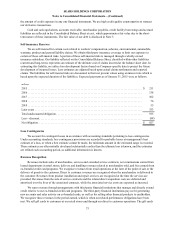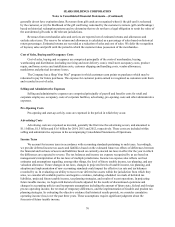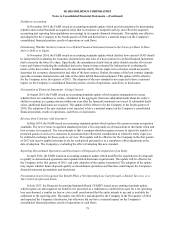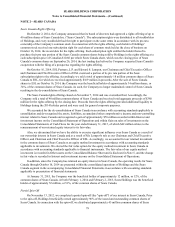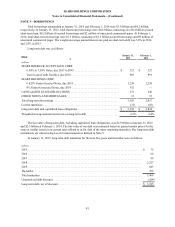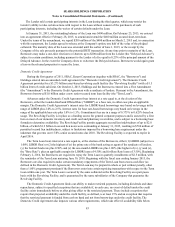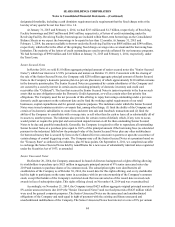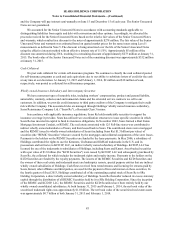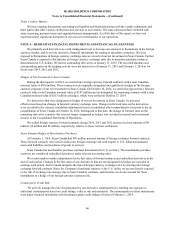Sears 2014 Annual Report Download - page 78
Download and view the complete annual report
Please find page 78 of the 2014 Sears annual report below. You can navigate through the pages in the report by either clicking on the pages listed below, or by using the keyword search tool below to find specific information within the annual report.SEARS HOLDINGS CORPORATION
Notes to Consolidated Financial Statements—(Continued)
78
Pushdown Accounting
In November 2014, the FASB issued an accounting standards update which provides guidance for determining
whether and at what threshold an acquired entity that is a business or nonprofit activity can reflect the acquirer's
accounting and reporting basis (pushdown accounting) in its separate financial statements. This update was effective
and adopted by the Company in the fourth quarter of 2014 and did not have a material impact on the Company's
consolidated financial position, results of operations or cash flows.
Determining Whether the Host Contract in a Hybrid Financial Instrument Issued in the Form of a Share Is More
Akin to Debt or to Equity
In November 2014, the FASB issued an accounting standards update which clarifies how current GAAP should
be interpreted in evaluating the economic characteristics and risks of a host contract in a hybrid financial instrument
that is issued in the form of a share. Specifically, the amendments clarify that an entity should consider all relevant
terms and features-including the embedded derivative feature being evaluated for bifurcation-in evaluating the
nature of the host contract. Furthermore, the amendments clarify that no single term or feature would necessarily
determine the economic characteristics and risks of the host contract. Rather, the nature of the host contract depends
upon the economic characteristics and risks of the entire hybrid financial instrument. This update will be effective
for the Company in the first quarter of 2015. The adoption of the new standard is not expected to have a material
impact on the Company’s consolidated financial position, results of operations, cash flows or disclosures.
Presentation of Financial Statements - Going Concern
In August 2014, the FASB issued an accounting standards update which requires management to assess
whether there are conditions or events, considered in the aggregate, that raise substantial doubt about the entity’s
ability to continue as a going concern within one year after the financial statements are issued. If substantial doubt
exists, additional disclosures are required. This update will be effective for the Company in the fourth quarter of
2016. The adoption of the new standard is not expected to have a material impact on the Company’s consolidated
financial position, results of operations, cash flows or disclosures.
Revenue from Contracts with Customers
In May 2014, the FASB issued an accounting standards update which replaces the current revenue recognition
standards. The new revenue recognition standard provides a five-step analysis of transactions to determine when and
how revenue is recognized. The core principle is that a company should recognize revenue to depict the transfer of
promised goods or services to customers in an amount that reflects the consideration to which the entity expects to
be entitled in exchange for those goods or services. This update will be effective for the Company in the first quarter
of 2017 and may be applied retrospectively for each period presented or as a cumulative-effect adjustment at the
date of adoption. The Company is evaluating the effect of adopting this new standard.
Reporting Discontinued Operations and Disclosures of Disposals of Components of an Entity
In April 2014, the FASB issued an accounting standards update which modifies the requirements for disposals
to qualify as discontinued operations and expands related disclosure requirements. The update will be effective for
the Company in the first quarter of 2015, and early adoption of the update is permitted. The adoption of the update
may impact whether future disposals qualify as discontinued operations and therefore could impact the Company's
financial statement presentation and disclosures.
Presentation of an Unrecognized Tax Benefit When a Net Operating Loss Carryforward, a Similar Tax Loss, or a
Tax Credit Carryforward Exists
In July 2013, the Financial Accounting Standards Board ("FASB") issued an accounting standards update
which requires an unrecognized tax benefit to be presented as a reduction to a deferred tax asset for a net operating
loss carryforward, a similar tax loss or a tax credit carryforward that the entity intends to use and is available for
settlement at the reporting date. The update was effective and adopted by the Company in the first quarter of 2014
and impacted the Company's disclosures, but otherwise did not have a material impact on the Company's
consolidated financial position, results of operations or cash flows.


